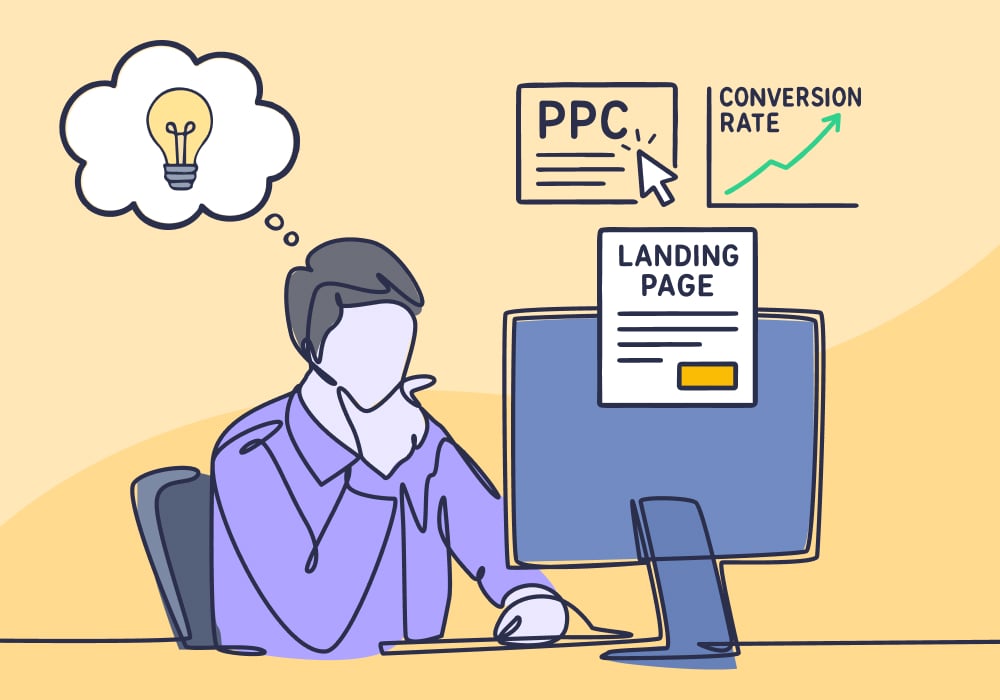
Marketers drive traffic. Great copy drives revenue.
Every marketer has felt the frustration: Your Google Ads campaign is humming. Clicks are coming in. Form fills are steady. But conversions? Stagnant.
The culprit often isn’t targeting or bidding—it’s the copy.
Even top-performing marketers overlook the fact that words are what ultimately move someone from curiosity to commitment. And while many rely on logic (features, benefits, pricing), behavioral science shows up to 95% of purchase decisions are made subconsciously.
In this guide, we’ll break down the seven psychological principles that make conversion copy work. You’ll learn how to write headlines, CTAs, and landing page text that resonates, persuades, and converts—especially for lead generation campaigns in industries like law, healthcare, home services, and real estate.
Let’s dive in.
Why Psychology Matters in Conversion Copy
Marketers often describe copywriting as part art, part science. The “science” part? That’s psychology—specifically, understanding how people really make decisions.
Here’s the truth: most buyers don’t weigh pros and cons in a spreadsheet before filling out a lead form. They respond to emotion, trust, urgency, and other subconscious triggers.
Emotion Is the Real Decision-Maker
People buy on emotion and justify with logic. That’s not just a saying—it’s backed by neuroscience. Behavioral researchers estimate that up to 95% of purchase decisions happen in the subconscious mind. If your copy doesn’t speak to those emotional drivers, it won’t move the needle—even if your offer is technically perfect.
“In Marketing, we think people make well thought out decisions, but very often people are affected by things they’re not aware of.” — Nancy Harhut, Behavioral Marketing Expert
Whether you’re selling HVAC services or legal consultations, your audience is feeling something: fear, hope, frustration, pride. The best copy makes them feel understood before it makes them act.
Trust, Fear, and Urgency Determine Action
If people don’t trust your claims, they won’t convert. If they don’t feel a sense of urgency, they’ll delay.
This is especially true in high-stakes industries like healthcare and legal, where skepticism is high. Only 1 in 3 consumers trust what a seller says about their own product. But 88% buy when they see the seller as a “trusted advisor.” Your copy needs credibility indicators—testimonials, certifications, data—to overcome that natural resistance.
And urgency? One campaign saw conversion rates jump from 3.5% to 10% simply by adding urgency messaging to the page. That’s nearly a 3x lift—just by tapping into the fear of missing out.
It’s Not Just More Leads—It’s Better Leads
“54% of marketers say that lead quality is their biggest challenge. It's not enough to know that someone filled out a form. That person could be a solicitor, a competitor, or someone lacking the budget for your product or service.” – Marketing ROI: How to Better Measure Marketing Success
Understanding buyer psychology isn’t just about getting more leads. It’s about getting better-qualified leads. Copy that connects on a deeper level attracts people who are truly motivated—and more likely to convert down the funnel.
For example:
- A generic home services ad might say, “High-Quality Window Replacements.”
- But a psychologically attuned version? “Drafty windows are costing you $300+ every winter. Stop the waste.”
- That’s loss aversion + urgency + clarity in action. Fewer clicks, but far better intent.
7 Psychological Principles That Power Conversion Copy
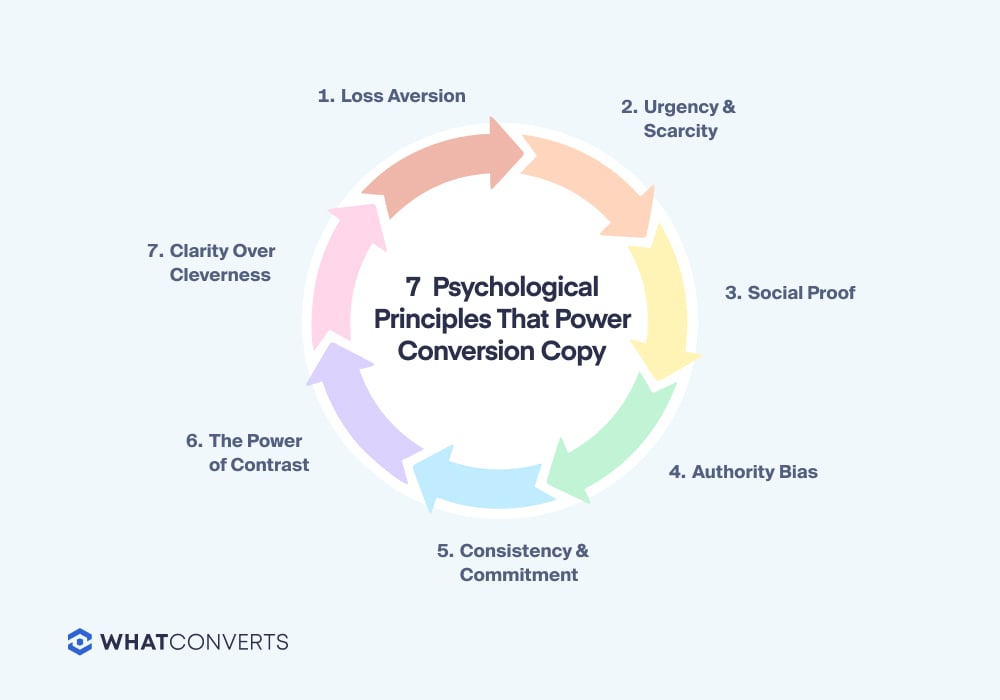
Each one includes implementation tips, real-world applications, and copy examples you can swipe and adapt.
1. Loss Aversion
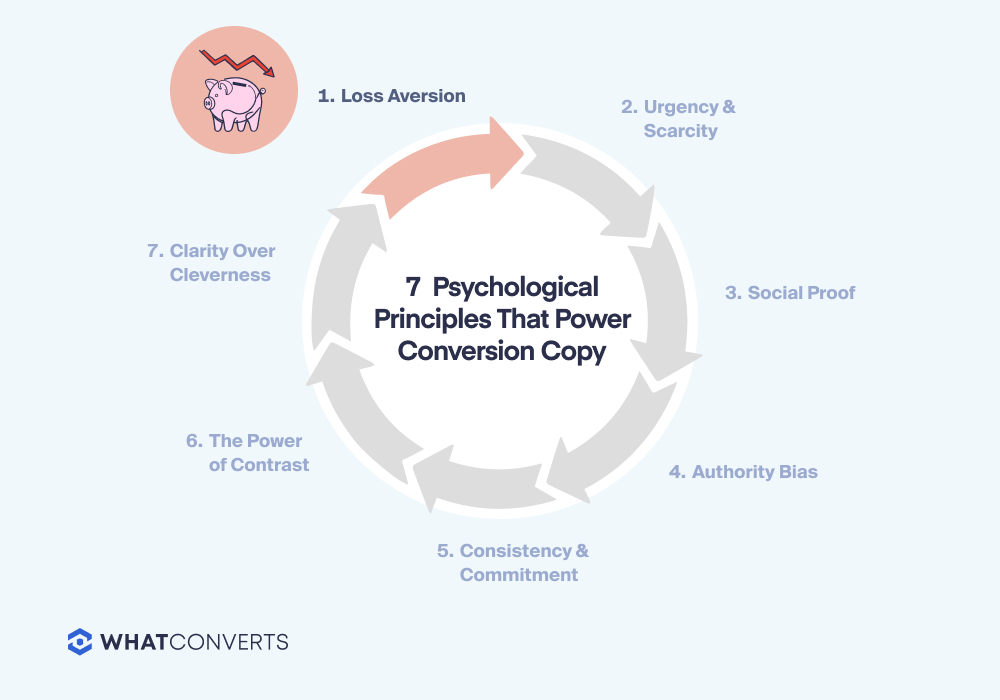
This isn’t just a theory—it’s one of the most reliable findings in behavioral economics, rooted in Kahneman and Tversky’s Prospect Theory. In practical terms, a potential loss feels twice as painful as an equivalent gain feels rewarding.
In marketing, this means prospects are often more motivated to take action if they believe it will help them avoid a loss, rather than simply obtain a benefit. It’s why a message like “Stop throwing $300 out the window every winter” often outperforms “Save $300 annually on energy bills.”
Why it works: Humans are wired to avoid pain or loss more than to seek gain. This principle—loss aversion—is particularly effective in lead generation when your goal is to push someone toward a decision or form fill. In a law firm ad, saying “Don’t risk losing your case by going it alone” strikes deeper than “Get expert legal help today.” It frames inaction as a danger, not a neutral choice.
One health communications study found that people were more likely to follow through with breast cancer self-exams when messaging focused on what they might lose (e.g., missing early detection), versus what they could gain. This loss-framed message spurred more action.
Real-world application across industries:
| Industry | Example Copy |
| Home services | “Every day your HVAC runs inefficiently, you’re burning cash.” |
| Medical | “Don’t let joint pain keep stealing your joy—take it back.” |
| Legal | “Waiting to file could cost you your right to compensation." |
Important: Loss aversion must be paired with a clear, credible solution. If you highlight the risk but don’t immediately offer a remedy, fear can cause paralysis instead of conversion. Anchor your CTA as the escape route:
“Stop the damage. Book your inspection today—before it gets worse.”
2. Urgency & Scarcity
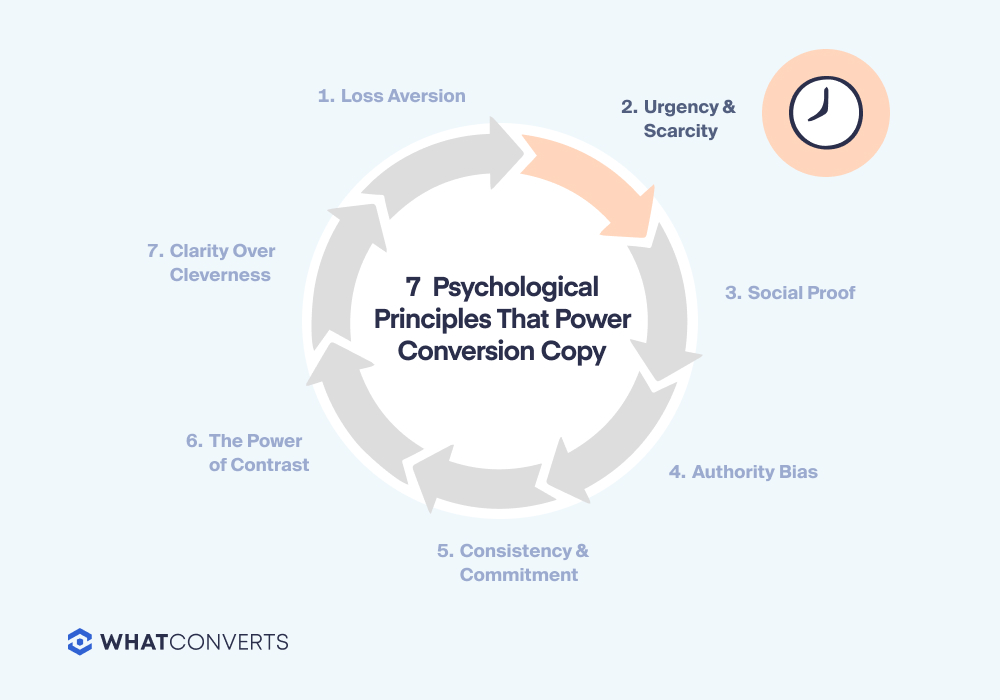
When something feels limited—whether by time or quantity—it instantly becomes more valuable in the eyes of your prospect. That’s basic human psychology. We’re wired to act when we think an opportunity is slipping away. This is why even the simplest change like adding “Only 5 spots left” to a headline can transform passive interest into decisive action.
Why it works: When we perceive time pressure or exclusivity, it disrupts our tendency to delay decisions. Plus, FOMO can be an incredibly powerful driver of action.
How to use it in copy:
- Use time-based urgency: “Offer ends Friday.”
- Add availability scarcity: “Only 3 appointments left this week.”
- Inject implied competition: “Spots filling fast—schedule yours today.”
The key is credibility. Fake urgency can erode trust. But real, verifiable constraints—limited time slots, deadlines, capped offers—drive conversions and still feel authentic.
Industry examples:
| Industry | Example Copy |
| Home Services | “Spring HVAC tune-up appointments are filling fast—book yours now.” |
| Mortgage Lending | “Rates are changing daily—lock in today’s low mortgage rate before it’s gone.” |
| Healthcare | “We’re accepting 10 new patients this month. Reserve your consultation.” |
Urgency also plays well with other psychological levers. For instance, urgency paired with loss aversion—“Miss this window and risk another month of high utility bills”—can supercharge response rates. And if you add in social proof—“Join the hundreds who already booked”—it becomes even more compelling.
Think of urgency as a catalyst when combined with an already compelling offer. It doesn’t replace value—it accelerates it.
How WhatConverts Helps
A/B test landing page copy to see which scarcity tactic drives the most qualified leads. You can easily see which Landing Pages drove the most conversions and sales revenue by opening up a landing page Quick Report.
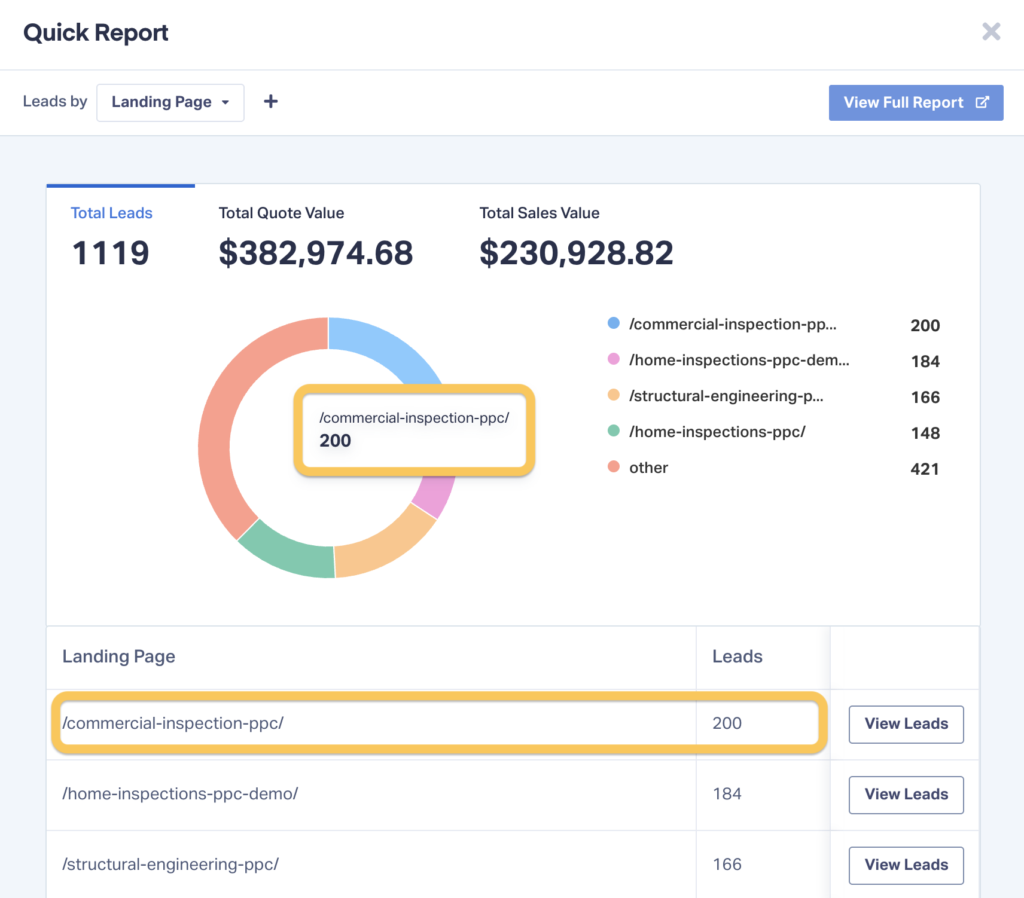
“The ability to see where leads are coming from—what source, what landing page, what keyword, what campaign—adds the level of proof we need to better shape our strategies and budget recommendations going forward.”

3. Social Proof
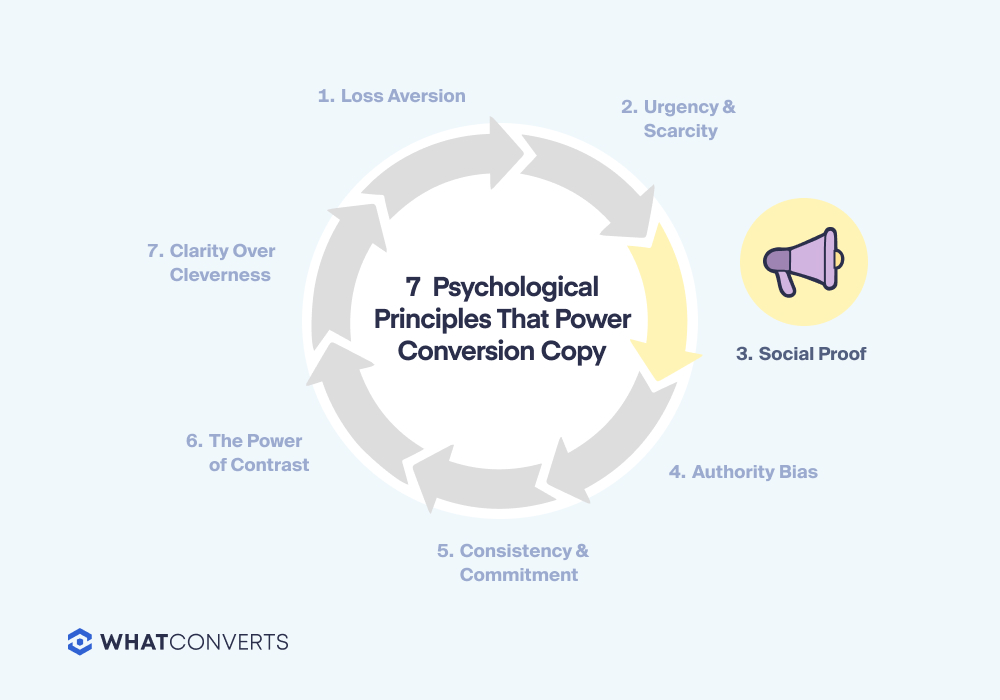
This is the essence of social proof: when we’re unsure, we rely on consensus. That might mean checking reviews, reading testimonials, or noticing how many others have taken the same action. It’s a psychological shortcut that reduces risk and builds trust—and it’s one of the most powerful drivers of conversion across all industries.
Why it works: Prospects trust peers more than they trust brands. It’s why the majority of viewers are going to be skeptical of your claims right off the bat. That said, 93% of millennials trust online reviews as much as personal recommendations, and even a single testimonial can increase conversions by 10%.
Forms of social proof you can use:
- Testimonials from real customers
- Star ratings and review stats
- User counts (“Trusted by 5,000+ businesses”)
- Case study outcomes
- Media mentions or “As seen in” logos
Copy examples:
- “‘This HVAC company cut our energy bill by 30%—best decision ever!’ – Jane D.”
- “Over 20,000 patients treated. 98% satisfaction rate.”
Industry-specific applications:
| Industry | Strategy |
| Law | Showcase case results, client testimonials, or bar association recognition. |
| Healthcare | Use patient satisfaction stats or certifications (“Board-certified, Mayo Clinic–trained”). |
| B2B | Display recognizable logos, expert endorsements, or quantifiable results. |
Pro tip: The more relatable your social proof, the stronger its impact. A testimonial from someone with a similar problem or demographic carries more weight than a generic quote. For example, a medical software vendor should showcase endorsements from other clinics, not generic B2B users.
Interestingly, 68% of consumers trust a brand more when they see a mix of positive and negative reviews. Don’t be afraid to highlight realistic expectations—it builds authenticity.
4. Authority Bias

Authority bias is our natural tendency to trust figures of authority—whether that’s a credentialed expert, a respected institution, or a familiar brand. In conversion copy, invoking authority is a powerful way to lower resistance, build credibility, and nudge prospects toward action—especially in industries where trust is everything.
Why it works: People are more likely to believe and act on claims that come from perceived experts. This principle is so strong that even subtle indicators of expertise—like quoting a doctor, displaying a certification, or referencing a media feature—can significantly increase conversion rates.
How to use it in copy:
- Reference titles and credentials: “Led by Dr. Jane Smith, a Mayo Clinic–trained orthopedic surgeon.”
- Mention certifications or awards: “Super Lawyers Rising Star 2023.”
- Include institutional endorsements: “As featured in Forbes, Inc., and NBC News.”
- Highlight years of experience or data scale: “25+ years in practice” or “based on 1 million+ transactions.”
Industry examples:
| Industry | Copy Example |
| Medical | “Board-certified physicians with decades of experience.” |
| Legal | “Over $10 million in client verdicts secured.” |
| B2B Saas | “Trusted by Cisco, IBM, and Adobe.” |
You can also subtly build authority through the tone and content of your writing. For example, referencing research or citing real numbers in your claims (“increase leads by 42% in 6 months”) sets a more expert tone than vague promises like “get more leads.”
It’s why we highlight our rankings from G2: 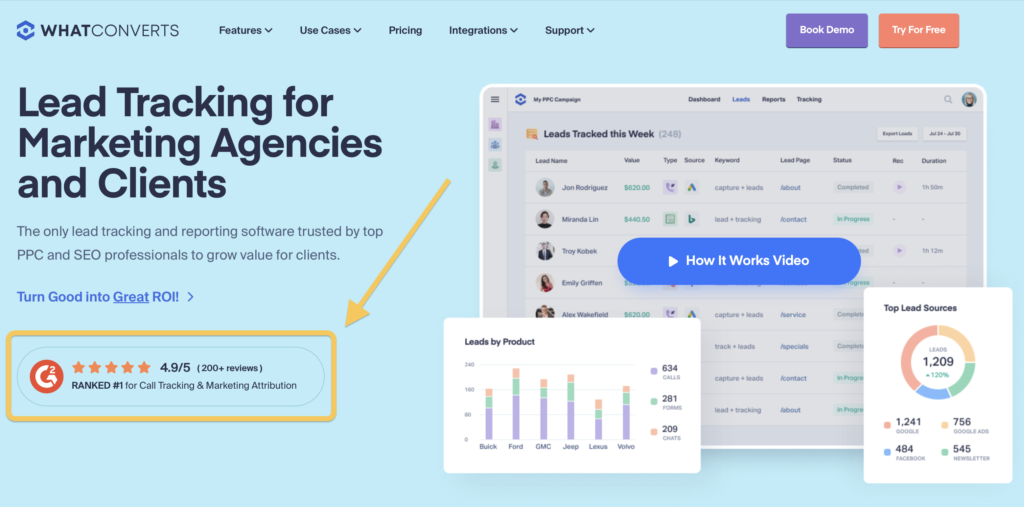
And use real case studies with tangible results in our marketing: 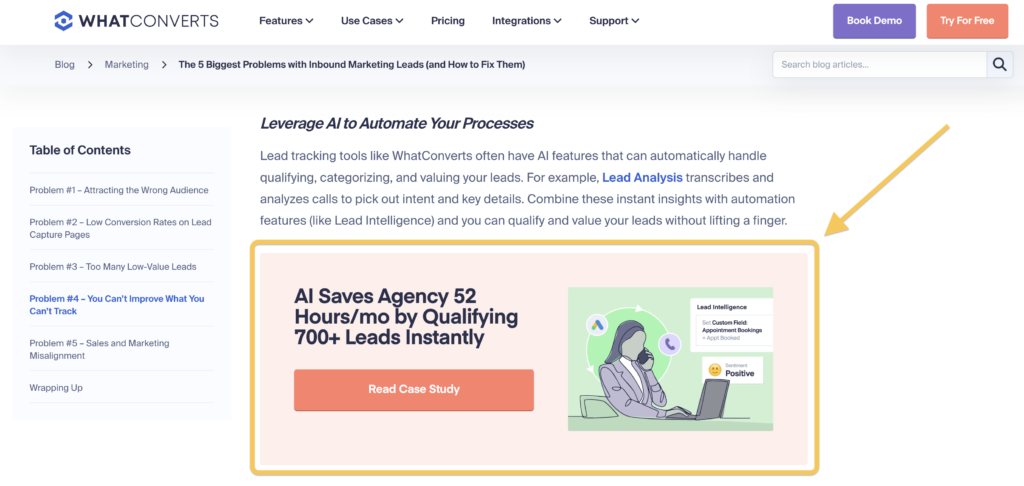
Pro tip: Authority bias pairs especially well with social proof. For example, quoting a well-known CEO who endorses your product or combining a testimonial with an award badge creates a double layer of trust.
Just don’t overdo it—your copy should still feel human and accessible. Authority earns attention, but clarity earns the conversion.
5. Consistency and Commitment
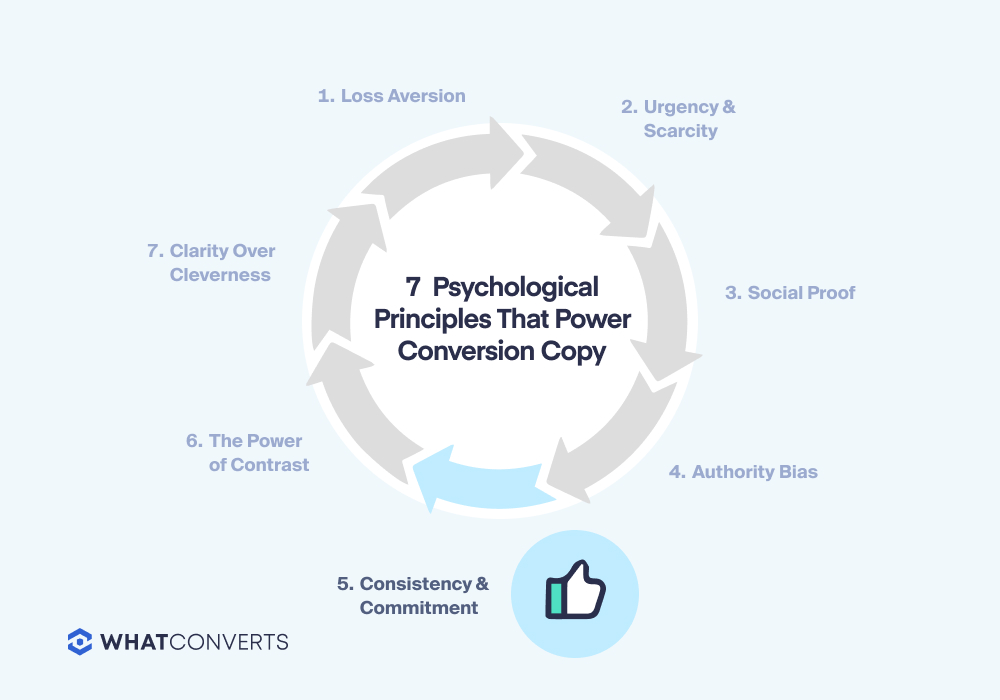
People have a strong internal drive to remain consistent with their past behaviors. Psychologists call this the Consistency Principle—once someone makes even a minor commitment, they’re far more likely to follow through with larger ones. In conversion copy, this means that micro-conversions (like clicking a button or answering a quiz question) pave the way for macro-conversions (like submitting a lead form or scheduling a consultation).
“As we make multiple small commitments, sometimes referred to as micro-commitments, we’re more likely to make a larger commitment later on. That larger commitment could be something which we may not have originally considered making.” – Will Schmidt, PhoneBurner
Why it works: The moment a prospect engages—even a little—they begin to justify that engagement internally. If they clicked “See if I qualify,” they’re now invested in getting that answer. That subtle self-perception (“I’m already halfway there”) pushes them to complete the process. It’s not just behavioral momentum—it’s identity reinforcement.
How to use it in copy and UX:
- Use multi-step forms: Start with a simple question (“What service do you need?”), then follow with contact info. Completion rates are often higher than single-step forms.
- Offer low-friction CTAs: “Check eligibility,” “Take a 2-minute quiz,” “Download the checklist.”
- Phrase CTAs as small affirmations: “Yes, I want to improve my marketing ROI.”
Real-world applications:
| Industry | Copy Example |
| Home Services | “Tell us about your home project.” |
| Healthcare | “Take our free health risk assessment.” |
| Legal | “Answer 3 quick questions to see if you have a case.” |
Pro tip: Even subtle cues can create commitment. A CTA like “Start my free trial” (first-person) creates more ownership and conversion momentum than the generic “Start free trial”—because the user feels like they’ve already opted in.
Ultimately, every click is a mini-yes. Design your copy to build on those yeses all the way to conversion.
How WhatConverts Helps
You can use WhatConverts to track both macro- and micro-conversions—all at both the individual and aggregate level.
For example, say you have a multi-step form (Step 1: Contact info, Step 2: Payment details) on several landing pages. With WhatConverts, you can see how many leads completed Step 1 on which page and how many completed Step 2. 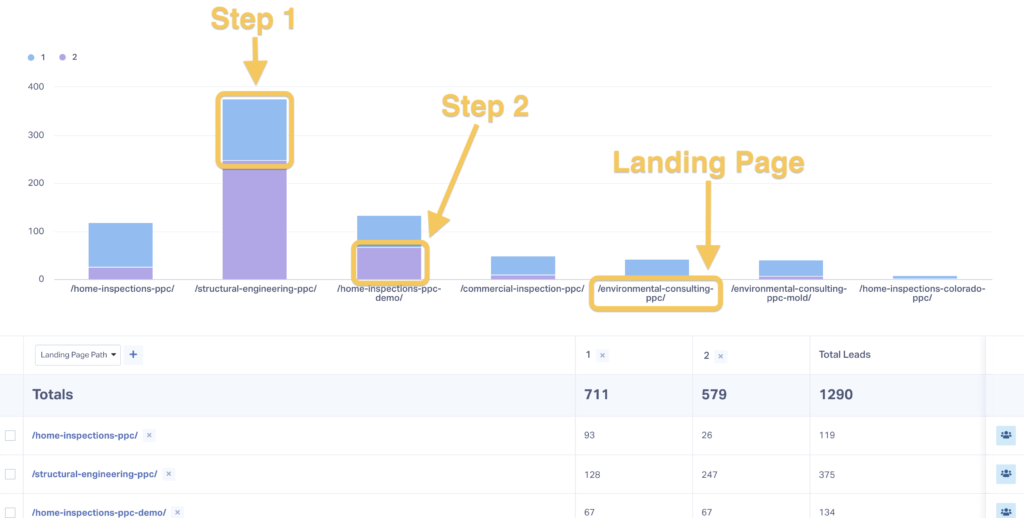
Plus, you can drill down into individual leads to see their complete customer journey: 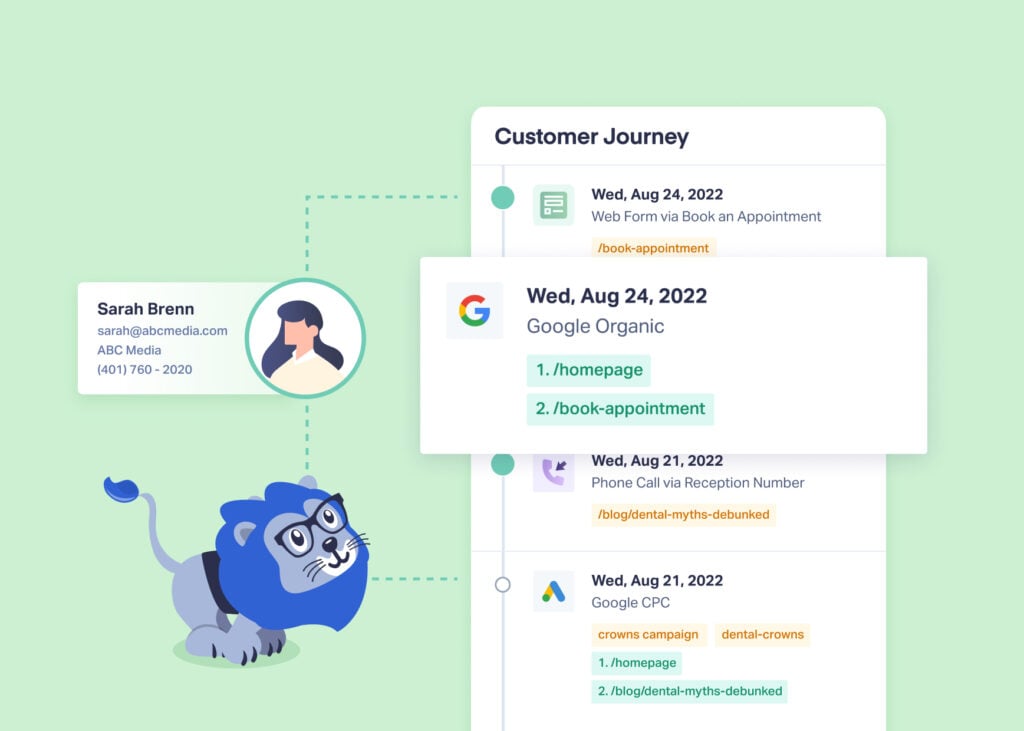
It’s this type of reporting power that helped Orbit Local increase their form submissions by 20%.
“I kind of think of WhatConverts as my secret weapon. The customer journey and multi-touch attribution lets us see all our leads’ touchpoints, from Google Ads and organic to remarketing campaigns.”
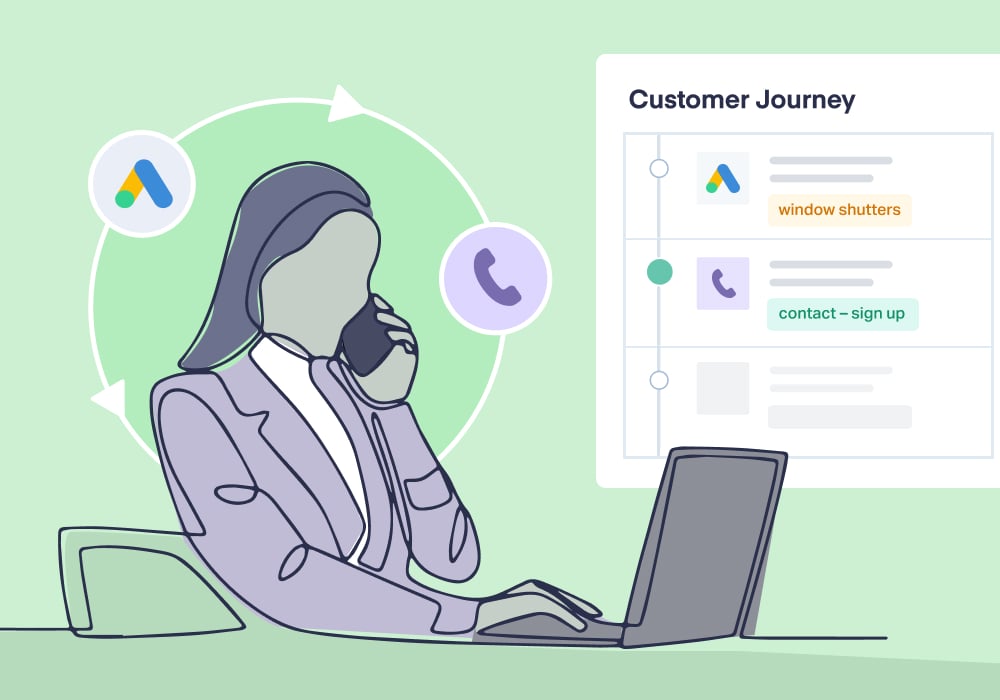
6. The Power of Contrast

This is the contrast effect in action: when presented with two scenarios—“before vs. after” or “with vs. without”—our brains are better able to evaluate value. In conversion copy, contrast helps prospects visualize transformation, which makes your offer feel more concrete and compelling.
Contrast adds meaning to your claims. It engages the imagination and helps prospects mentally place themselves in both the pain of the current state and the relief of the future one.
Why it works: Humans rarely assess something on absolute merit. Instead, we make decisions relatively—how does this option stack up against the alternative? By using contrast in your copy, you guide the prospect’s mental model of what they’re avoiding and what they stand to gain.
How to use it in copy:
- Frame messages as “before vs. after” stories.
- Use “with vs. without” phrasing to show risk vs. reward.
- Highlight emotional and tangible improvements (time saved, money retained, frustration eliminated).
Example (Before/After):
- “Before: You’re chasing down leads with zero visibility. After: You know exactly which keywords and campaigns drive revenue.”
Example (With/Without):
- “Without a proper HVAC tune-up, you risk a mid-summer breakdown. With it, your system runs efficiently all season long.”
Industry-specific examples:
| Industry | Copy Example |
| Legal | “Before: Facing the insurance company alone. After: $90K settlement with expert legal help.” |
| Home Services | “Drafty windows, rising energy bills… or a warm, efficient home that saves you $1,200/year.” |
| B2B SaaS | “Without attribution: guesswork. With WhatConverts: clear ROI from every lead source.” |
Even visual contrast—like before/after photos or side-by-side comparison tables—can dramatically increase user engagement and conversions, especially in home services and healthcare.
Pro tip: Use realistic, relatable contrasts. If your “before” state sounds catastrophic or exaggerated, readers will tune out. The most effective contrasts are authentic and attainable, helping the prospect imagine a real transformation they believe is possible.
7. Clarity Over Cleverness
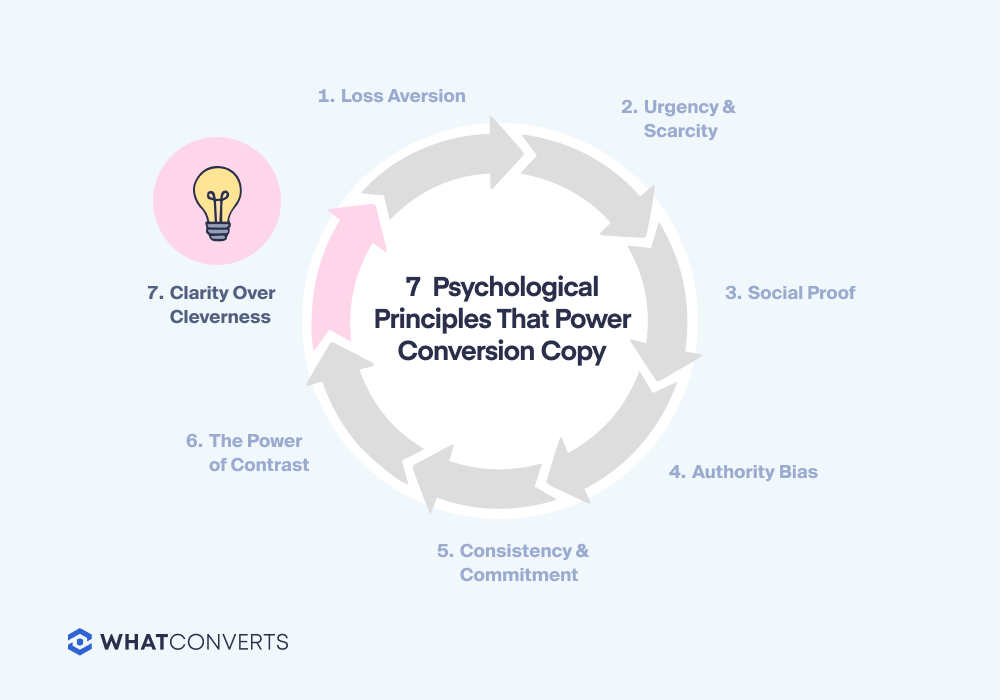
Marketers often fall into the trap of trying to sound witty, innovative, or “different.” But if your prospect has to work to understand your offer, you’ve already lost them. This principle—cognitive fluency—tells us that people naturally gravitate toward things that are easy to understand, and they’re more likely to trust and act on messages that are processed effortlessly.
“The marketer’s art is not persuasion; it is clarity. Indeed, when the marketer represents an authentic value proposition, clarity is persuasion.” — Flint McGlaughlin, The Marketer as Philosopher
Why it works: When readers don’t understand what you’re offering, who it’s for, or how it helps them—immediately—they bounce. The brain equates ease of processing with truth and credibility. This is especially critical for high-intent lead gen where attention spans are short and skepticism is high.
How to use it in copy:
- Focus on benefits over features.
- Use everyday language—avoid industry jargon unless your audience uses it fluently.
- Keep headlines direct: who you help, what you offer, and the outcome.
- Use short paragraphs, bullet points, and scannable formatting.
Industry examples:
| Industry | Avoid | Use |
| Legal | “Your Justice Journey Starts Here.” | “Get a Free Consultation to Win Your Injury Case.” |
| Healthcare | “Reimagining Wellness for Modern Lives.” | “Book Same-Day Appointments with Certified Local Doctors.” |
| Home Services | “Bringing Comfort to Every Corner.” | “24/7 HVAC Repair—Get Your AC Fixed Today.” |
Formatting also matters. Clear subheadings, bolded value statements, and bullet points reduce friction. Skimmers should be able to grasp your pitch in seconds.
Research even shows that clear fonts and familiar words make statements feel more credible—a psychological effect linked to cognitive fluency (Deep Research – Clarity Converts).
Pro tip: Clarity isn’t boring—it’s persuasive. When your copy removes ambiguity, you’re not dumbing it down—you’re making it actionable.
Wrapping Up
If your conversion copy isn’t rooted in human psychology, it’s not doing its job. By leveraging triggers like loss aversion, urgency, authority, and cognitive ease, you can turn casual visitors into committed leads.
But insight alone isn’t enough. You need visibility into what actually works—and that’s where lead tracking tools like WhatConverts come in.
Want to see which messages drive real leads and revenue?
Start your free 14-day trial of WhatConverts today or book a demo with a product expert to see how we help prove and grow your ROI.
Get a FREE presentation of WhatConverts
One of our marketing experts will give you a full presentation of how WhatConverts can help you grow your business.
Schedule a Demo
Grow your business with WhatConverts





